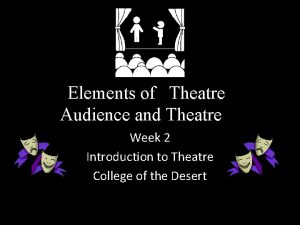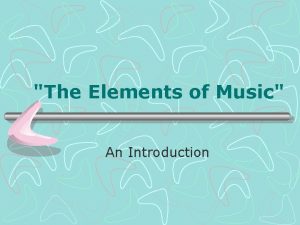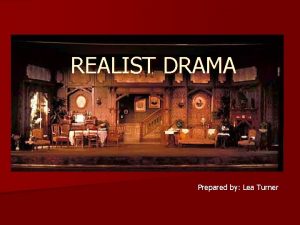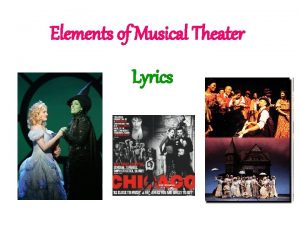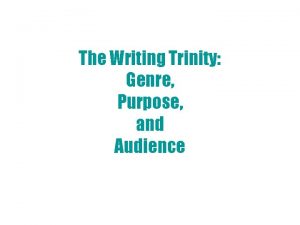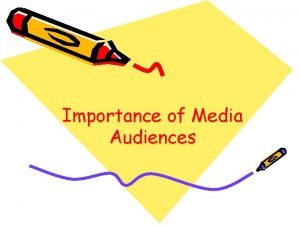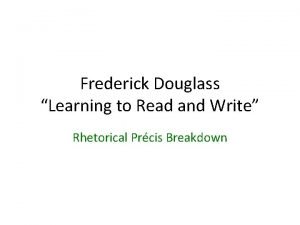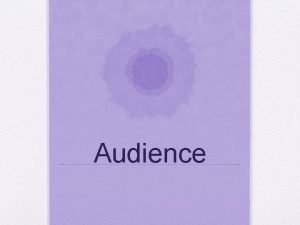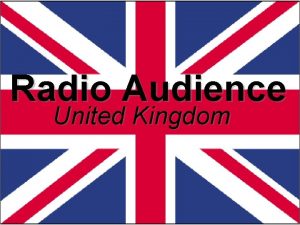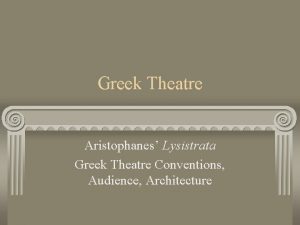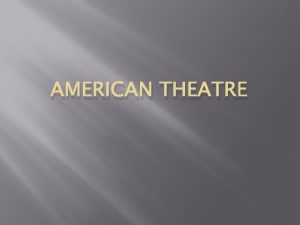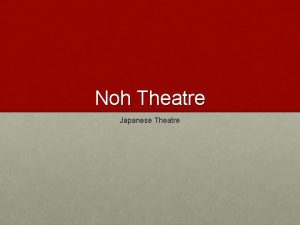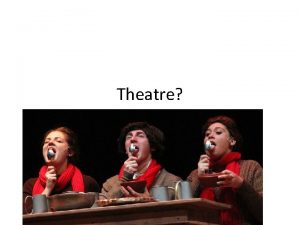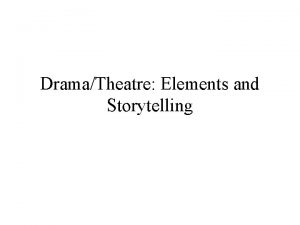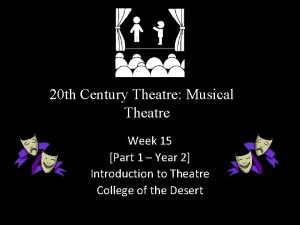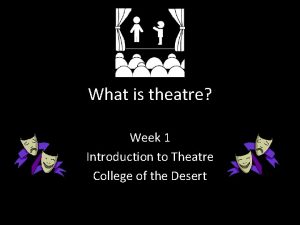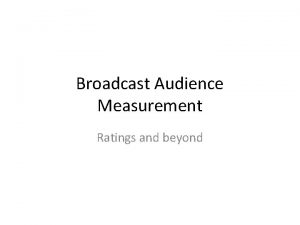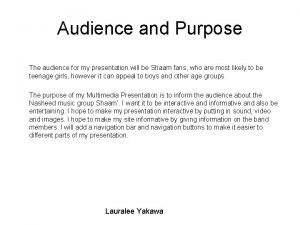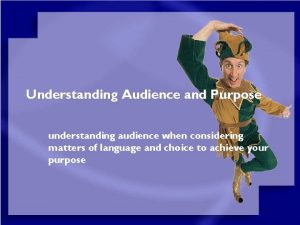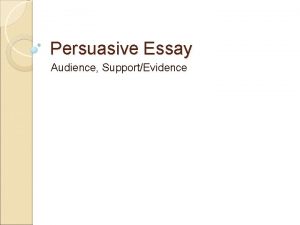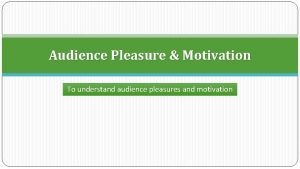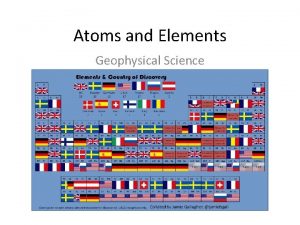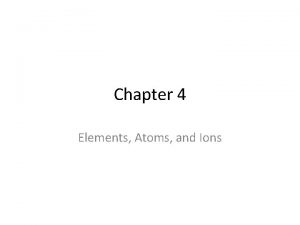Elements of Theatre Audience and Theatre Week 2























- Slides: 23

Elements of Theatre Audience and Theatre Week 2 Introduction to Theatre College of the Desert

Theatre as an Art Form Theatre is a Literary Art : The Play • • • Perhaps the only concrete and lasting (permanent) element of theatre is the play itself. The other elements are moments in time (non-permanent), audiences only experience them once. Except for perhaps set and costume design, of which photos can keep a permanent record. We have to look at the play in combination with its time and place – its context – for better understanding. What makes a good play? • • Theorists throughout history have disagreed and bickered about what makes a good play. Most base their arguments at least in part on Aristotle or variations of Aristotle – The Poetics (334 BC) – disagreeing, or reinterpreting. Although there is not one coherent theory of a good play, many basic premises have been determined by which we can evaluate a script – realizing, however, that our criteria may not necessarily be the same as the criteria for a good play when the play was written – how the play was looked at at the time. Interpretations / evaluations are different based on different ways of looking at the world, at people, at life, and at the nature and purpose of theatre. By looking at various theories and examining play scripts of different styles and periods, our ability to discern and evaluate aesthetic elements of the drama will become more important.

Theatre vs. Drama • • • The word theatre comes from the Greek “theatron, ” literally "seeing place, " or "place where something is seen. " The word was first used in its current form in 1576 when James Burbage named his playhouse the Theatre. Since Burbage’s playhouse was one of the first, if not the first, structure built specifically for the production of plays, the name theatre eventually came to mean first the buildings and then the entire genre. The companion term drama comes from the Greek word dran, literally "to do. " It is "something done. " Frequently the terms are used interchangeably, although theatre always refers to the structure where the performances are held as well as to the company of players who perform. Theatre also refers to the designers, administrators, technicians, etc. who work together to produce plays as well as the body of ideas that animates the artists and brings the plays to life. Drama is a more limited term and tends to refer mainly to the plays that are produced. In other words, drama is the script itself; theatre is all the elements that combine to bring that play to life.

Who is James Burbage and why should we care about him? According to the Elizabethian-Era. com, “James Burbage was an Elizabethan entrepreneur. He realized considerable profit by staging plays at Elizabethan Inn-yards and had the vision to build 'The Theatre' and the 'Globe'. He was at the forefront of the early days of Elizabethan commercial theatre and played an important part in the history of the Globe Theatre and William Shakespeare. James Burbage was born in 1531 and is said to have been born at Stratford-upon. Avon. ” “The Theatre was designed as a construction which was similar to a small Roman amphitheater - the Elizabethan Amphitheatre. They modified the features of the existing blood sport rings with the addition of a fixed stage, unlike the trestle supported stage used in the innyards. This allowed the new stage productions to become far more sophisticated. Plays featured the use of props such as canons (although these massive props often had to be left on stage for the entire performance) and a much larger stage area for the actors which was complete with trapdoors. ” An Elizabethan Theatre

What is a play? What is involved? • Drama requires the reader to contribute more than any other form of literature does. • Not only must the reader see and understand what is explicitly said and done, but he must also be aware of all that is merely implied or left unsaid. – READ STAGE DIRECTIONS. Frequently at the beginning of the play, the playwright or someone will have described the set. Make a little sketch of it if you have to. You MUST be able to visualize what is going on as you read. • Dramatic Action - A play is a representation of people in action. The term, action means more than just physical movement, it involves the motivations as well, the person’s thoughts and feelings, as well as deeds. It is what he does and why he does it. • Because each playwright is unique, his/her plays are unique; however, good plays tend to have qualities in common.

• What is a play? What is involved? Dramatic action should be: – Purposeful - Organized to arouse a specific response, such as pity, fear, laughter, anger, etc. – Varied - variety in plot, ideas, mood, characterization, spectacle necessary to avoid dullness or predictability. – Engage and maintain interest - situation should be compelling enough to arouse interest; issues must be vital enough to arouse concern; or aural/visual devices must be sufficiently novel enough to hold interest. – Probable - Within the world of the play, events must be logical. As a play progresses, its guidelines are revealed. The audience then expects the playwright to observe the rules he has established. Even if the playwright wants to show that life is inconsistent, he must be consistent in his inconsistency. • For example, at the beginning of the play, The Bald Soprano, a clock strikes 17 times, and Mrs. Smith promptly announces that it is 9 o’clock. Despite the title of the play, there is no soprano, bald or otherwise. This warns the audience that nothing is logical in this play.

Theatre as an Art Form Theatre is a Performing Art: The Production • • • The production itself is shortly-lived and immediate. People view productions as “the home of the now, “ at least for the time the audience experiences the performance. Robert Edmund Jones (early 20 th century scenic designer) claimed that performances were where people could be "aware of the now. " An art for everyone. Acting, directing, design, construction, running crew (musicians, singers, dancers) are all working together to create a production. A mixture of all the arts – making it either the least pure or the most pure. Needs talent and skill to plan and execute, from all elements of the production. The final product is a result of the efforts of many. We can increase aesthetic and technical appreciation for the individual arts going into making theatre and for the different styles and periods of theatre.

Who is Robert Edmond Jones? Why should we care about him? Robert Edmond Jones was born on December 12, 1887, in the township of Milton, New Hampshire, roughly halfway between Portland Portsmouth, in a house built by his great grandfather Levi Jones. Edmond Jones (1887 -1954) designed scenes for theater that were simple and conducive to a more complete and coherent collaboration between the director and the designer. His work provided the foundation for the whole present day tradition of scene design in the United States. Perhaps his most famous written work is The Dramatic Imagination, published in 1941. This collection of essays defined an understanding and respect for the art of theater that was as relevant over 40 years later as at the time it was written.

Theatre is a Major Form of Entertainment • Theatre holds the audience's attention – the primary form of public entertainment until the advent of radio and movies. • Theatre is fun – Theatre is play (work, food, exercise) for the soul, for the mind, for the body. • All work and no plays would be boring. • Eric Bentley – suggested the concept of "eros" is essential for theatre – actual sweating breathing human beings in front of us – “eros” being the drive of creativity and love

What is the Eros Theory? • A concept developed by Sigmund Freud • Eros is the internal drive of life and creation • The word Eros translated from ancient Greek translates to love, but more on the emphasis of romantic and intimate love. • Eros is better known in ancient Greek culture as striking individuals with lustful passion often with “arrows of love, ” we know Eros more by his Latin counter-part Cupid.

What is the Eros Theory? • Some of the more famous Greek myths involving the Greek goddesses involve lust and the consequences, such as Hera and the swan. • Freud was not the first philosopher to contemplate the ideas of Eros, lust, and love. Once again going back to the ancient Greeks, Plato philosophized that Eros had two dimensions where we love not only by sensual and lustful attractions, but also an internal love that goes beyond mere physical attraction. • According to Joseph Brown, “Freud believed that we derive pleasure from creation and creation can come in many forms. ” • Freud believed we derive pleasure from being creative from making things, so in a sense it can be seen as almost biological.

Examples of people using Eros Theory • Composers such as: – Ludwig Von Beethoven – Franz Schubert – Richard Wagner • These composers had musical compositions that went against the Classical style of compositions of Mozart and Bach during the Romantic Era of music because the music of Beethoven and Wagner had more emotion and feeling from their music, in fact the entire music industry from past to present shows the exact meaning of Eros pleasure from creating on the basis of merely wanting to create. • Whereas painters and sculptors like… – Leonardo Da Vinci – Michelangelo – Vincent Van Gogh • … were paid to create and one could argue that they did not create for pleasure

Examples of people using Eros Theory The Culinary World: • If there were no creativity in the culinary world, we could merely survive on the bare basics of nutrition, however just looking at such cuisines as Italian, Indian, and Mexican we see a plethora of different flavors ranging from bold to subtle and we derive pleasure from consuming and creating these dishes. • If it were so basic that humans were like any other animal like the behaviorists assume, humans wouldn’t have such a vast culinary palette. We would consume foods in their most basic forms and that would be it.

What is the Eros Theory? The Negative Side: • Love has lust which if unchecked can lead to unspeakable perversions: – Rape – Pedophilia • Creativity has given us: – the airplane – harnessing electricity – works of art • On the other hand, it has also given us: – Machine guns – Atomic weapons – And the different means of hurting our fellow man

Who is Sigmund Freud? According to biography. com, “Sigmund Freud was an Austrian neurologist best known for developing theories and techniques of psychoanalysis. ” “Freud was born in Freiberg, which is now known as the Czech Republic, on May 6, 1856. Freud developed psychoanalysis, a method through which an analyst unpacks unconscious conflicts based on the free associations, dreams and fantasies of the patient. His theories on child sexuality, libido and the ego, among other topics, were some of the most influential academic concepts of the 20 th century. ”

Theatre as Performance: • Requires an audience a group of individuals gathered together at a certain time and place for no purpose other than to see the performance (though some may be doing other things: placing bets, writing reviews, wasting time, etc. ) that is aware of itself as a group. Audience: • The audience for a theatre performance has artistic self-awareness. • Audience for sports (spectators) – competition – outcome is not predetermined (as it is with most theatre – though some plays have varied outcomes (Sheer Madness, The Night of January 16, and The Mystery of Edwin Drood, for instance, have endings determined by the audience).

Theatre vs. Other Arts ART FORM Represents (Abstract or Concreate) Uses what senses? Must Use Space Must use Time Is the Artist Present? Music Abstract--Could be considered the most pure-uses only one sense. Hearing No Yes ? Graphic Art Concrete/Abstract Sight Two Dimensions No No Sculpture/ Architecture Concrete/Abstract Sight Two Dimensions No No Dance Concrete/Abstract Sight and Hearing Two Dimensions Yes Literature Abstract (Uses words Sight and Imagination Not the work itself. (The book exists physically, but what is the "literature? ") To read, yes, but varies from reader to reader. No Either the least pure or the most pure—uses all the sense A mixture of the all the Arts--Uses space, time, (Literature) dance (Movements) Architecture, Graphic Design, Music (Sound) Yes to convey both concrete and abstract ideas; cognitive Theatre ) Both concrete and abstract and imagination through IMITATION: "MIMESIS"

Different Types • • • Types of performances: – Movie, dance, television, opera, music, salesmen, preachers, teachers, drill sergeants – all are theatrical / theatre-like. Kinds of arts: – Dance, music, movies, television, opera, painting, architecture, graphic arts, literature, performance art -theatre. Kinds of Stages: – Location can shape many aspects of a performance.

Types of Stage Spaces The Proscenium or Traditional Stage Pros of the Proscenium Stage: • Can use lots of scenery-allows for a "realistic" visual "picture frame. " • More realism possible • Easier to light (from one direction. ) • Room backstage • Uses traditional stage areas (upstage, downstage etc. )

Types of Stage Spaces Arena Stage (Theatre-in-the-Round) Pros of the Arena Stage: • • Very intimate-closer to the action than with a proscenium stage; can see other audience members across the stage Lends itself to varied kinds of plays Cons of the Arena Stage: • • • Can't use very realistic scenery Someone's back is always facing the audience Can't use traditional stage areas

Types of Stage Spaces Thrust Stage (Three-quarter Round) Pros of the Thrust Stage: • Blend of proscenium and arena • Versatile • Can use big, realistic sets • Still have intimacy Cons of the Thrust Stage: • Must use/rearrange some audience space

Types of Stage Spaces Flexible Stage Pros of the Flexible Stage: • Uses the environment that already exists in a room/space • Sometimes audiences can be in the performance space • Sometimes performers within audience space • Uses available space, modified or no • Includes the Alley Stage – which is like a runway

Works Cited Biography. com Editors. (2017, April 28). Sigmund Freud. Retrieved August 16, 2017, from https: //www. biography. com/people/sigmundfreud-9302400 Brown, J. (n. d. ). Thanatos and Eros. Retrieved August 16, 2017, from http: //www. academia. edu/4551692/Thanatos_and_Eros Robert Edmond Jones. (2017, August 11). Retrieved August 16, 2017, from https: //en. wikipedia. org/wiki/Robert_Edmond_Jones “Robert Edmond Jones Facts. ” Biography, Love. To. Know, Corp, biography. yourdictionary. com/robert-edmond-jones. Accessed 16 Aug. 2017.
 Invoked audience
Invoked audience Elizabethan theatre and audience summary
Elizabethan theatre and audience summary Week by week plans for documenting children's development
Week by week plans for documenting children's development Importance of audience in theatre
Importance of audience in theatre What are performance elements in drama
What are performance elements in drama Dramatic elements of a play
Dramatic elements of a play Elements of art color
Elements of art color Introduction to the elements of music
Introduction to the elements of music Realist drama
Realist drama Musical theatre lyrics
Musical theatre lyrics Drama study design
Drama study design Oracle landed cost management
Oracle landed cost management Atomic elements vs molecular elements
Atomic elements vs molecular elements Http //elements.wlonk.com/elements table.htm
Http //elements.wlonk.com/elements table.htm Common themes in folktales
Common themes in folktales 3 elements of a folktale
3 elements of a folktale Genre purpose and audience
Genre purpose and audience Audience analysis memo
Audience analysis memo Relationship between media and audience
Relationship between media and audience Learning to read and write frederick douglass audience
Learning to read and write frederick douglass audience What does tone mean in soapstone
What does tone mean in soapstone A deli sells 640 sandwiches
A deli sells 640 sandwiches Pros and cons of a four day school week
Pros and cons of a four day school week Days of the week and months of the year
Days of the week and months of the year



